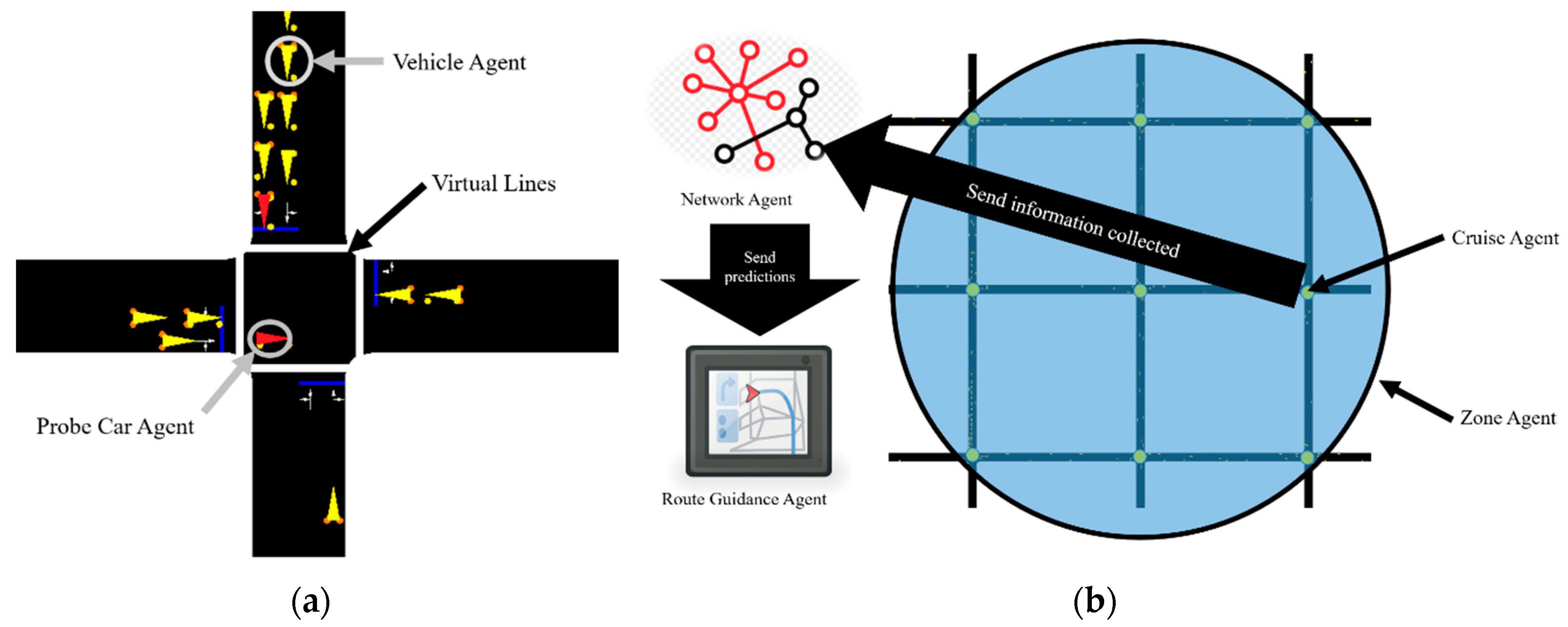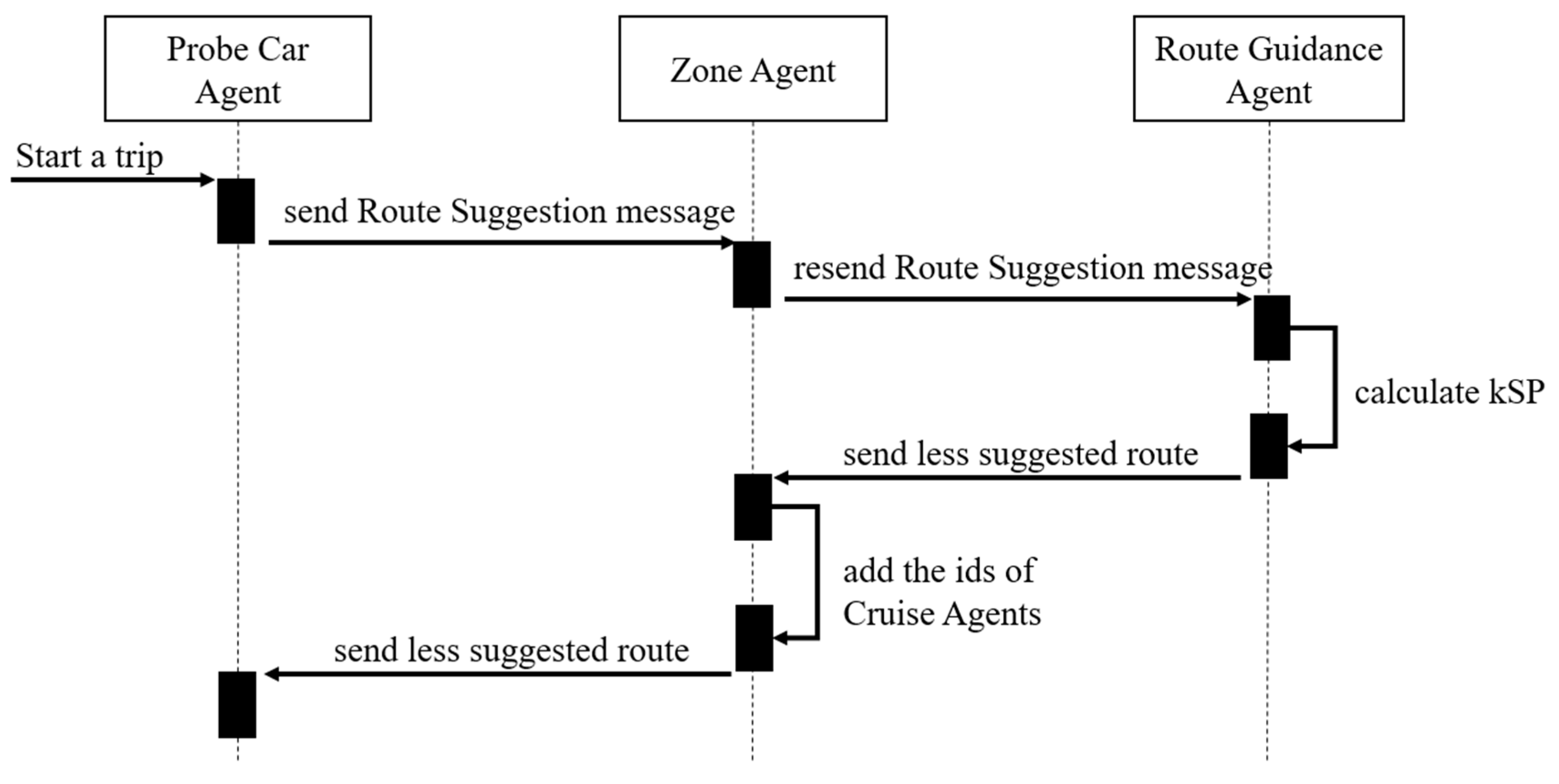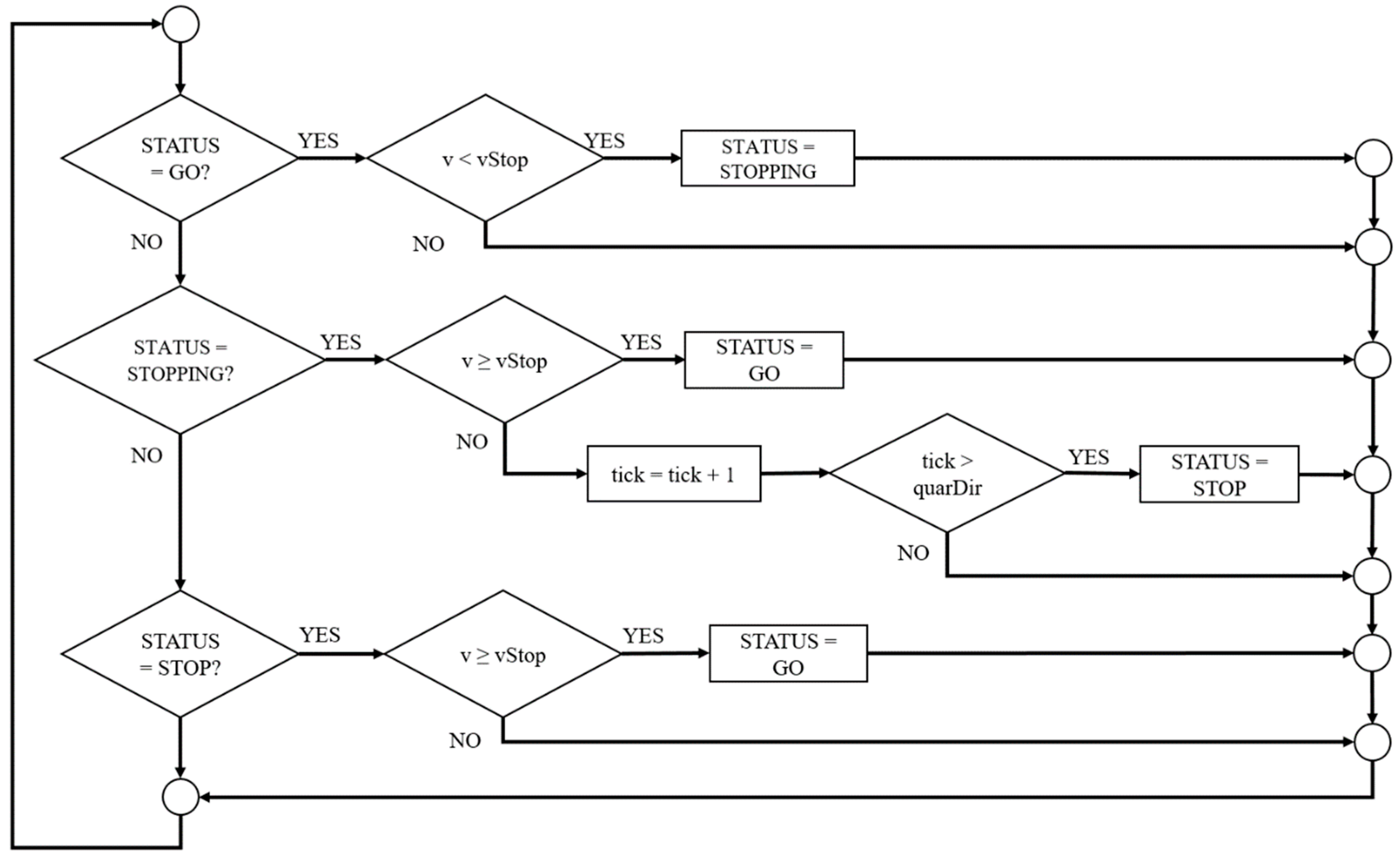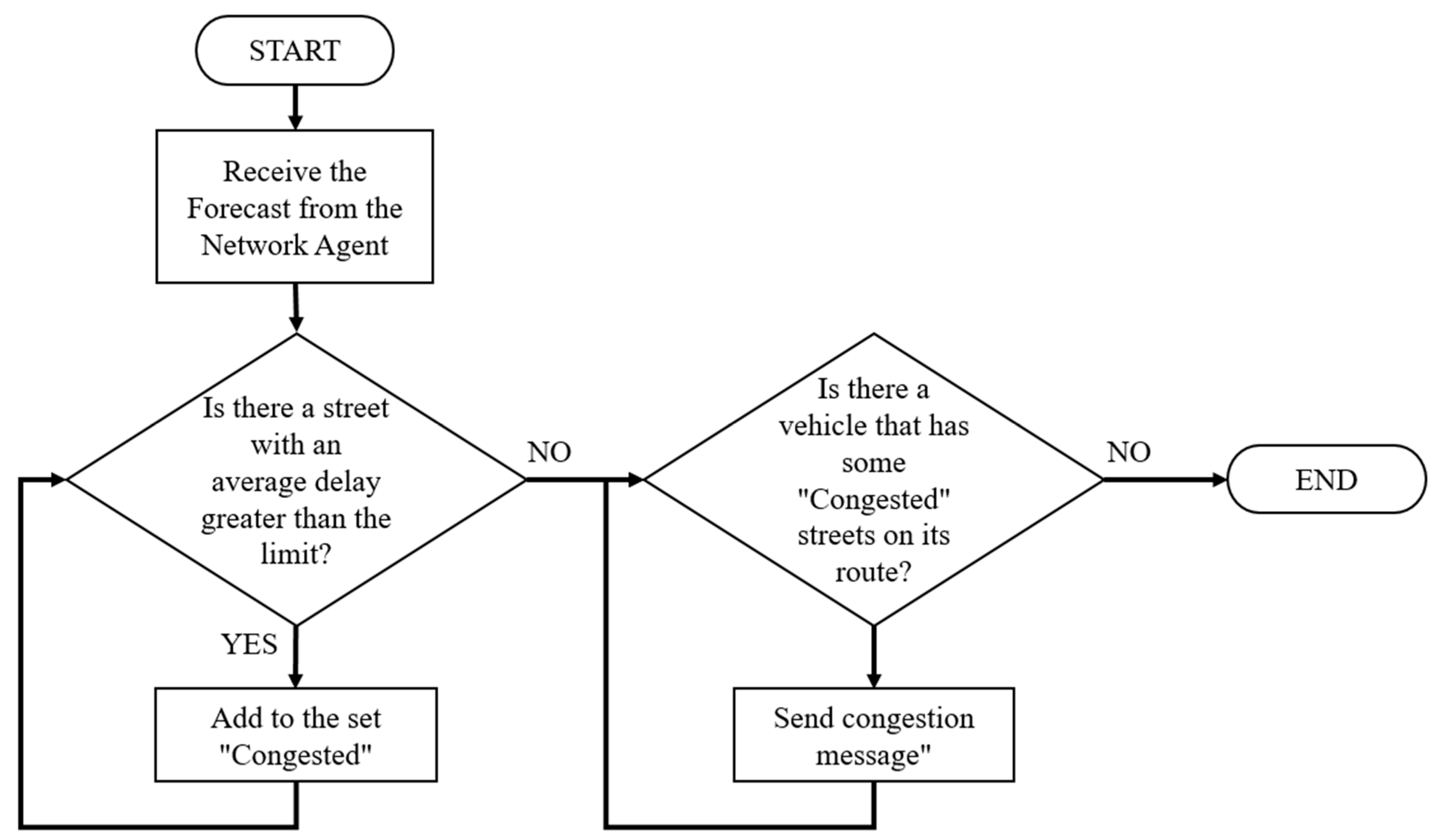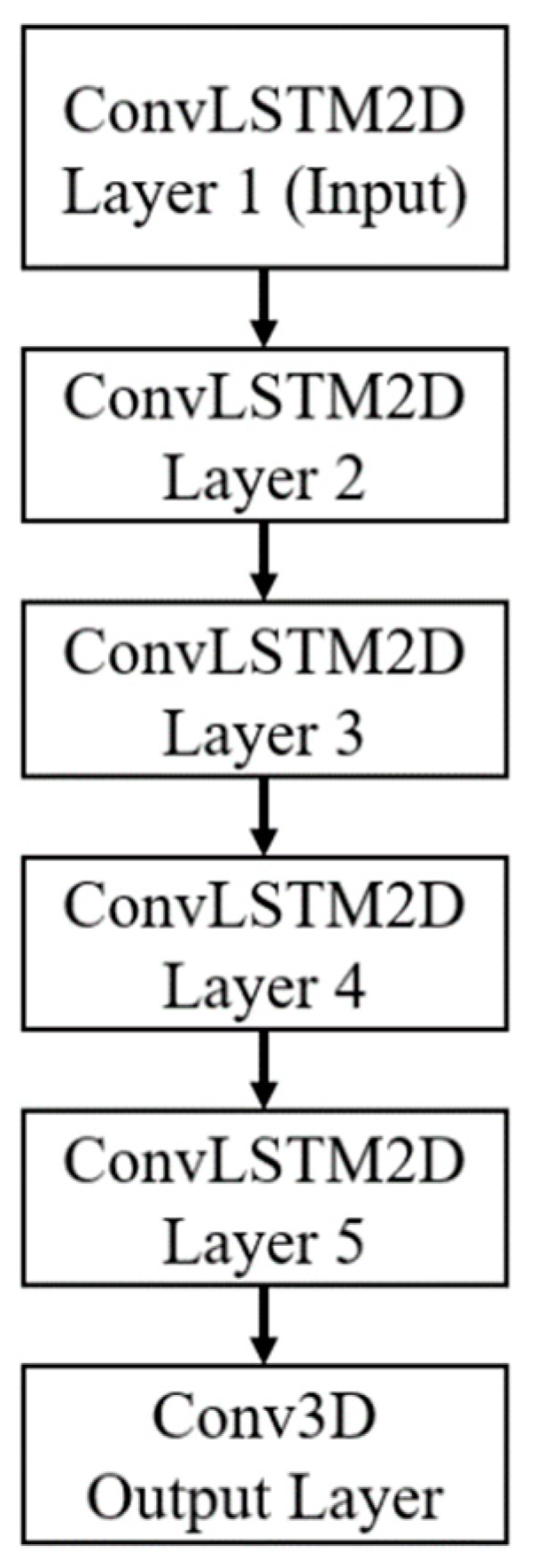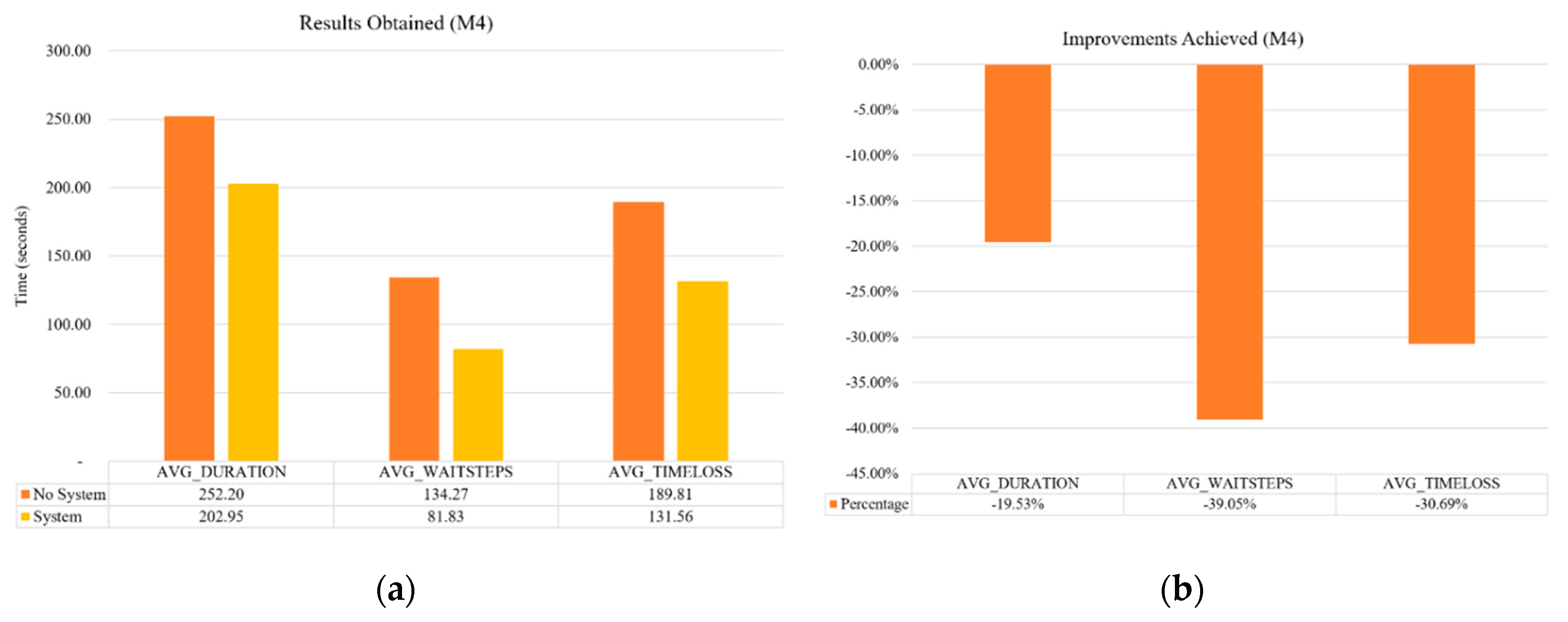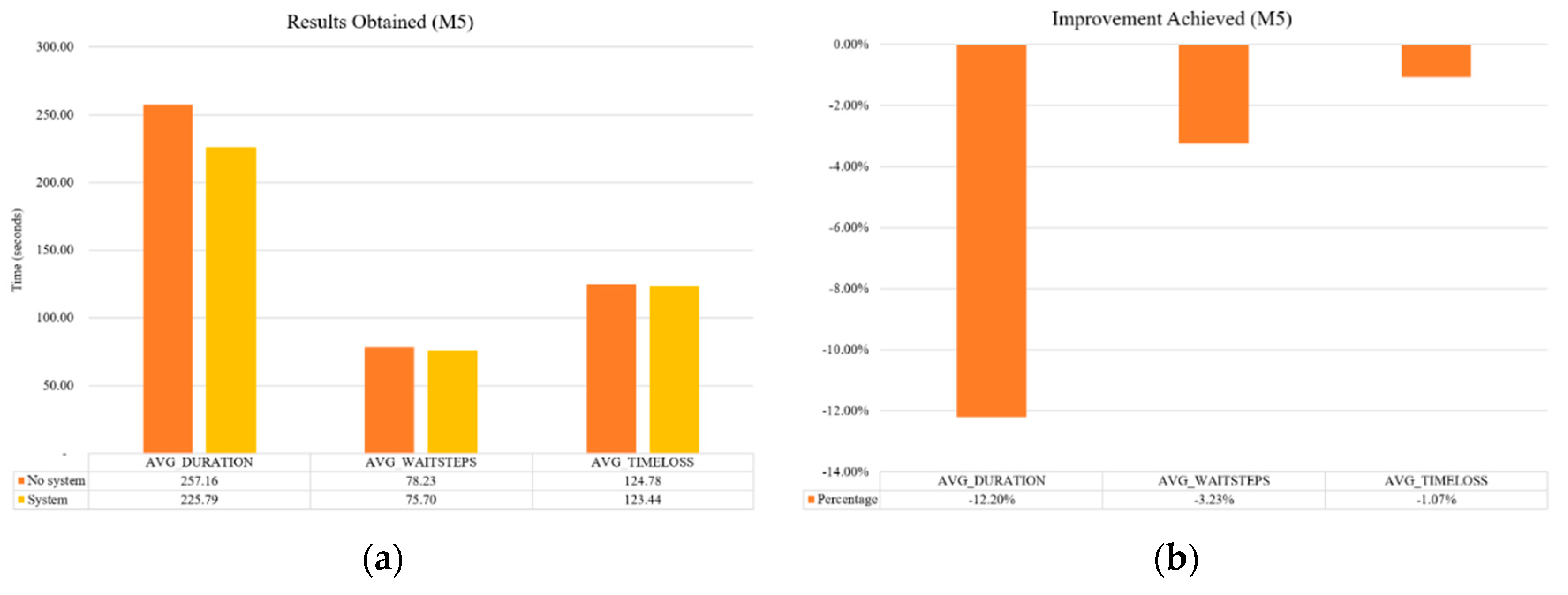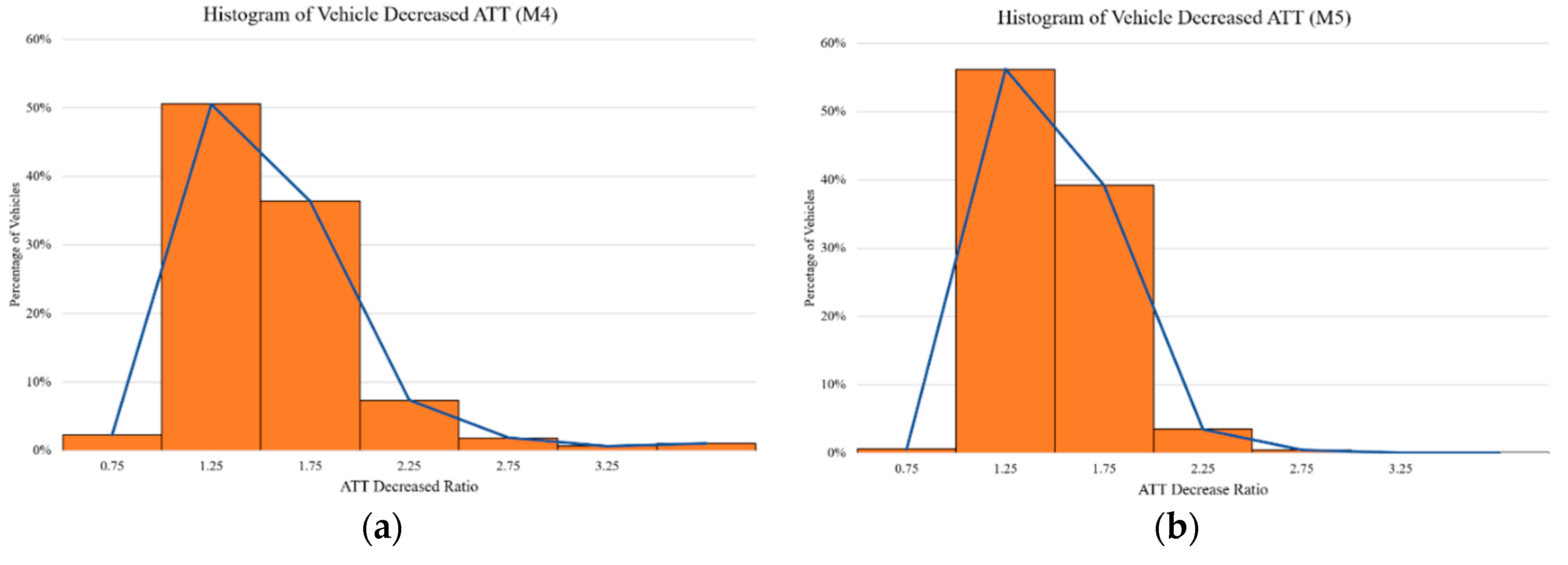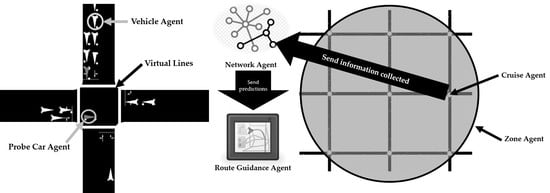1. Introduction
Excessive population growth in urban areas is one of the biggest challenges for every government around the world. The congestion generated by public and private transport is the most important cause of air pollution, noise levels, and economic losses caused by the time used in transfers, among others. For example, the inhabitants of Mexico City lose an estimated 23 h per month in transfers, which translates into losses of more than 1.5 billion dollars per year, which means 1% of the Mexico City’s contribution to the country’s GDP, a very significant figure for a developing country [
1].
The implementation of vehicular network standards and advances in wireless communication technologies has enabled the implementation of intelligent transport systems (ITS). One of the objectives of ITS is the real time traffic management using vehicle data collected from the road infrastructure. With this data, it is sought to characterize the traffic and thus be able to detect, control, and minimize traffic congestion. The main challenge of this approach is to forecast the congestion and re-route the vehicles without causing new congestion in other places [
2].
Commercial solutions such as Waze [
3] and Google Maps [
4] are capable of providing alternative routes from origin to destination based on the traffic information published by users. Although these systems are capable of predicting long-term traffic congestion as well as its duration, they are often used with reactive solutions that still cannot prevent congestion. In addition, the routes suggested to users are based exclusively on the algorithm of the shortest route to their destination, without taking into account the impact that the re-routing has on future traffic conditions [
5].
In this work, we present a predictive congestion avoidance by re-routing system that uses a mechanism based on deep learning with the goal of characterizing the future traffic conditions to make an early detection of congestion. Based on these predictions and a short route generation algorithm, alternatives for the vehicles that are about to cross the possible congested areas are provided. In addition, the system uses vehicle to infrastructure communications (V2I) for the early detection of non-recurrent congestion. The results obtained from simulations in synthetic scenarios have shown that the proposal is capable of reducing the average travel time (ATT) by up to 19%, benefiting a maximum of 38% of the vehicles. The rest of this document is organized as follows. In
Section 2, previous research in this field is summarized.
Section 3 presents the details of the proposal.
Section 4 presents the tools used in the development of the proposal and the scenarios used for the evaluation.
Section 5 shows the obtained results. Finally,
Section 6 presents conclusions and future work.
2. Related Work
CoTEC [
6] (Cooperative Traffic congestion detECtion) is a cooperative vehicle system based on vehicle-to-vehicle (V2V) communication. This system uses fuzzy logic to detect local traffic conditions, using beacon messages received from surrounding vehicles. When detecting congestion in the area, CoTEC activates a cooperative process that shares and correlates the individual estimates made by the different vehicles, thus achieving a characterization of the degree of traffic congestion. Tested in large scenarios, COTEC obtained good results in the detection of congestion; however, it does not integrate any vehicle re-routing strategy.
Araujo et al. [
7] present a system, based on CoTEC, called CARTIM (identification and minimization of traffic congestion of cooperative vehicles). CARTIM, like CoTEC, uses fuzzy logic to characterize road traffic, adding a heuristic that seeks to reduce drivers’ travel time by allowing them to modify their travel routes, thus improving vehicle flow in the event of congestion. The authors report that CARTIM achieves a reduction of 6% to 10% in ATT.
Urban CONgestion DEtection System (UCONDES) [
8] is another proposal based on V2V communications that use an artificial neural network (ANN) designed to detect and classify existing levels of congestion in urban roads. The proposal also adds a mechanism that suggests new routes for drivers to avoid congested areas. The ANN uses the speed and traffic density of a street as input to determine the existing level of congestion: light, moderate, and congested. The vehicles receive the classification obtained, as well as a new route, through beacon messages so that the vehicle can alter its current route and thus avoid congested roads. The simulations carried out in a realistic Manhattan scenario showed a reduction of 9% to 26% of ATT.
SCORPION [
9] (A Solution using Cooperative Rerouting to Prevent Congestion and Improve Traffic Condition) uses vehicle-to-infrastructure (V2I) communications. All vehicles send their information (id, current position, route, and destination) using 4G and LTE technologies to the nearest road side unit (RSU), which uses the k-nearest neighbor algorithm to classify street congestion. After determining the traffic conditions, a collective re-routing scheme plans new routes to those vehicles that will pass through congested areas. Like the UCONDES system, SCORPION performed simulations using a realistic Manhattan scenario, achieving a 17% reduction in the ATT. The aforementioned proposals present some limitations, such as a limited re-routing distance, no real-time mechanism for the detection of congestion or no mechanism for re-routing with a global perspective.
Pan et al. [
5] propose a centralized system that uses the data obtained in real-time of the vehicles (position, speed, and direction) to detect traffic congestion. Once the congestion is detected, the vehicles are redirected according to two different algorithms. First, the shortest dynamic path (DSP), which re-routes vehicles using the shortest routes that also, has the lowest travel time. The authors also mention that a defect of this algorithm is the possibility of moving the congestion to another point. To solve this, a second algorithm, random k-shortest path (RkSP), randomly chooses a route between k shorter routes. The objective of this algorithm is to avoid switching the congestion from one place to another and, in this way, to balance the redirected traffic between several routes. This scheme does not implement a mechanism in real time to detect congestion as it occurs; it is only able to detect it during the next phase of re-routing.
One way to improve the above mentioned solutions, it is to forecast the state of vehicular traffic and, in this way, anticipate congestion. Kumar [
10] proposes a traffic prediction system using the Kalman filtering technique. The predictive model uses historical and real-time information when making the prediction. Despite showing very good results in terms of prediction, the proposal does not include redirection strategies in case of congestion. Another point to consider is that this model works in a single street segment, which does not allow to determine its efficiency on a global scale (the entire vehicular network).
From the perspective of machine learning, traffic prediction is a spatio-temporal sequence prediction [
11]. Recently, long short-term memory networks (LSTM) have gained popularity as a tool for the prediction of spatio-temporal sequences [
12]. LSTM are a special type of recurrent neural network (RNN) that have been shown to be able to learn long-term dependencies [
13,
14,
15]. Hochreiter and Schmidhuber [
14] introduced them. The RNNs work very well with a wide variety of problems and, because of this, are widely used today. LSTMS are specifically designed to avoid the problem of long-term dependency. Each cell acts as an accumulator of state information and controlled by a set of cells that determines the flow of information. There is a gateway that allows you to control whether the incoming information is going to be accumulated or not. There is also an oblivion door, which allows us to determine if the state of the previous cell will be taken into account. In addition, an output cell determines whether the output of the cell is to be propagated to the final state. The cell type and control gates are the most important advantage of the LSTMs since they get the gradient trapped in the cell and prevent it from disappearing too fast, which is a critical problem of the basic RNN model [
15]. Xingjian et al. [
12] developed a multivariable version of LSTM that they called ConvLSTM, which has convolutional structures in both state-to-state and state-to-state transitions. By stacking multiple ConvLSTM layers, they were able to build a model that proved to have excellent spatio-temporal sequence prediction capability, suitable for making predictions in complex dynamic systems.
DIVERT [
16] is a distributed hybrid vehicle redirection system to avoid congestion. This system uses a server and Internet communication to determine a precise global view of traffic. Although, DIVERT presents improvements in ATT, the comparison is made with respect to a centralized re-routing system and does not make any comparison against a scenario without any strategy.
Next route routing (NRR) [
17] extends the functionality of the SCATS system (Sidney Coordinate Adaptive Traffic Systems) by adding vehicle congestion and re-routing detection mechanisms. The re-routing decision is made taking into account the travel destination and the current local traffic conditions. The proposed architecture allows the positive impacts of re-routing to spread over a larger area. The results obtained show a reduction of 19% in ATT. It is necessary to emphasize two points on this proposal. First, it is an extension of a previous system (SCATS), it is not an autonomous system. Second, it requires that all vehicles provide information to know the real state of the traffic.
4. Performance Evaluation
4.1. Tools Used
The set of tools used for traffic simulation is composed of two main components: Simulation of Urban MObility (SUMO) and TraCI4J. SUMO [
21] is an open source program for urban traffic simulation. It is a microscopic simulator; that is, each vehicle is modeled explicitly, has its own route and moves independently through the network. It is mainly developed by the Institute of Transportation Systems. The version used in this work was version 0.25.0, published in December 2015. TraCI4J [
22] is an Application Program Interface (API) developed for SUMO that allows communication in time of execution between the proposed system and the simulator. TraCI4J was developed by members of ApPeAL (Applied Pervasive Architectures Lab) of Politecnico di Torino. This API offers a higher level of abstraction and better interoperability than other APIs developed for the same task.
Keras was used for the implementation and training of deep architecture. Keras [
23] is a high-level neural network API, developed in Python and capable of running over TensorFlow, CNTK, or Theano. In our case, and intending to take advantage of a server with two NVidia GTX 1080 cards, we chose to use TensorFlow [
24] as a backend.
4.2. Test Scenario
After reviewing previous works, we observed that one of the most used scenarios to evaluate proposals is the scenario known as Manhattan (or grid type) [
25,
26,
27]. In our case, two synthetic networks were designed based on the Manhattan scheme: one of the 4 × 4 (M4) and another 5 × 5 (M5). For example, 5 × 5 means that this map has five intersections on the vertical and horizontal axes. All segments of the street have a length equal to 200 m and each of them consists of two lanes with opposite directions.
4.3. Simulation Setup
SUMO includes a set of applications that help prepare and perform the simulation of a traffic scenario. A simulation scenario can contain a large number of vehicles and their routes. Even for small areas, such as the test traffic networks, it is almost impossible to define traffic demand manually. For this reason, we use two of the tools included in SUMO, “randomTrips.py” [
28] and duarouter [
29], to generate the traffic demand of a full day for the synthetic networks M4 and M5. With the intention of simulating the traffic of one day as realistic as possible, we define three traffic flows: LIGHT (5–20% of maximum capacity), MEDIUM (60–70% of maximum capacity), and HEAVY (80–95% of maximum capacity). The distribution of these traffic flows are shown in
Table 1.
Depending on the flow defined for a certain period of the day, a random amount of trips are made and distributed evenly throughout that period. A trip describes the movement of a vehicle from a street of origin to a street destination, time of departure, and route followed. Although the trips are generated randomly, each one of them meets a series of requirements:
They have a minimum distance. In the case of the M4 network, the minimum is 600 m. While for the M5 network, the minimum is 800 m.
The start and end streets are selected at random. Nonetheless, the tools allow favors to the streets that are in the periphery of the network.
The algorithm used to generate the route is the Dijkstra [
30] algorithm.
The trips generated are stored in a configuration file that defines the traffic demand that will be used in the simulation.
To generate the dataset necessary for deep architecture training, we perform 2400 simulations using the previously generated traffic demand file, but using a different pseudo-random number as seed for each simulation. During these simulations, all the vehicles reported the delay when traveling on a street the segment (1). With these reports, every 300 s, an adjacency matrix is generated with the average delays of each of the streets of the synthetic network (2). The simulation of a full day generates 288 matrices of this type containing the traffic behavior of the 24 h. The values are normalized using the Min-Max technique (3) and stored in a file for later use.
The files obtained are divided at random into two groups: training (80%) and validation (20%). Regardless of the group, each file contains a spatio-temporal sequence of P measurements of a region of size M × N. For example, for the M5 network we are talking about 288 measurements of a 5 × 5 region.
Initially, a two-layer architecture was implemented and evaluated. The training files are segmented using a 20-measurements-wide sliding windows (5 for input and 15 for prediction). The initial network consisted of two ConvLSTM layers with each layer containing 64 hidden states and 3 × 3 kernel. We used a per-GPU batch size of 16 and trained with Adam optimizer, setting learning rate to 10
−4. This architecture worked correctly, achieving 75% accuracy. To increase the accuracy of the model, a new ConvLSTM intermediate layer was added. This process is repeated four times more, using the same hyperparameters each time. After several test with different configurations, it was determined that the best configuration was a deep five-layer ConvLSTM network (
Figure 5), with an accuracy of 88%. This architecture proved to have a more accurate spatiotemporal sequence prediction capability, which makes it suitable to provide predictions in complex dynamic systems such as the problem of traffic flow prediction.
With the intention of to obtain baselines to determine the efficiency of the proposal, we decided to run two groups of simulation, each with 100 simulations were carried out. The first group has no components of the proposal were used. However, this time, SUMO was configured to generate an output file that contained all the information related to each vehicle’s trip: the departure time, the time the vehicle wanted to start, the time of arrival, the total duration of the trip, the distance traveled, the number of times the route changed, among other registered values. With these values as a basis, it was possible to determine both the general and the individual performance.
4.4. Performance Metrics
As we mentioned at the beginning of this document, the goal of the proposed sample is to mitigate the congestion of the streets and, at the same time, minimize the average travel time (ATT). The ATT is calculated using (4). We use this metric because its reduction leads to lower fuel consumption, greater economic growth, and better life experience for citizens [
31].
5. Results
The second group were executed again, using, this time, the components of the proposal with the parameters presented in
Table 2. It is also necessary to highlight that:
Only 10% of the population reports the delay they experience when crossing a street (probe cars) and only they receive notifications of congestion on their travel route.
If the system does not have updated information of a certain area or street, a forecast is generated on the status of that area for the next 300 s.
All the simulations continue until all vehicles complete their trips.
In both test traffic networks, M4 and M5, we observed important reductions in the average travel time, the waiting time (the time when the vehicle speed was below 0.1 m/s) and the loss of time (the time lost due to driving below the ideal speed). In the case of the M4 network, we observed a reduction of 19.53% in the average time of travel, as well as a reduction of 39.05% in the waiting time and a 30.69% in time loss (
Figure 6).
With regard to the M5 network, the results obtained were also very good. A reduction of 12.20% in ATT was obtained, as well as a reduction of 3.23% in the waiting time and of 1.07% in time loss (
Figure 7).
Figure 8 shows the histograms of the improvements of ATT under normal traffic conditions when we use the proposed system. In this case, the improvement ratio is defined as
ratio = oldtime/newtime. For example, a ratio of two means that the vehicle was able to complete its trip in half of the time, while a ratio of three means that it finished its trip in one-third of the previous time. As we observed, a large number of vehicles, 51% (M4) and 56% (M5), saved 20% of the travel time (ratio 1.25). Although we can also observe that, there are vehicles that could avoid the worst part of the traffic by completing their trip two or three times faster (relations 2 and 3).
6. Conclusions and Future Work
The congestion caused by public and private transport is the main cause of many of the problems that cities face today. The best approach to solve this congestion is a more efficient use of the installed road infrastructure. The use of intelligent transportation systems (ITS) technologies can optimize the route, reducing distances, increasing safety in transport, reducing the time spent in traffic jams, reducing fuel consumption, and improving air quality. In this document, we present a platform that continuously monitors the traffic flow status in a specific geographic area and provides a congestion detection and warning service. This allows vehicles to adjust their route from their current point to their destination when the system detects congestion on this route, even when the vehicle is already moving. The proposed system also considers those situations for which it is not possible to obtain updated information, using a real-time prediction model based on a deep neural network. The results obtained from a series of simulations carried out on two synthetic scenarios show that the proposal is capable of generating improvements in ATT for each of the scenarios analyzed, achieving better results than other existing proposals.
It is important to mention that the proposal is not expensive, nor difficult to implement, since it does not require specialized infrastructure that requires installation and maintenance. The proposal requires a distributed computational architecture to accommodate the different agents that make up the proposal, and a small number of cars equipped with smartphones operating as probe cars. A good choice of probe cars would be public transport vehicles, since when traveling through the main streets of the city; they could provide relevant information, thus benefiting a large part of the population. In addition, for those streets where there is no updated information, the platform can generate good approximations of the real traffic conditions using the predictive model developed in the proposal.
As part of future work, we will further evaluate the proposal with real data. For this, we have already selected a sub-scenario of TAPASCologne 0.17.0 [
32]. TAPAS Cologne is an open project that provides a large-scale data set that allows you to make, using SUMO, a very realistic urban vehicle simulation. This scenario uses a real Cologne map drawn from OpenStreetMap [
33] is used and generates a traffic demand of 6:00 a.m. at 8:00 a.m., using the methodology of Simulation of Travel and Activity Patterns (TAPAS) and the dynamic assignment algorithm called Gawron.
